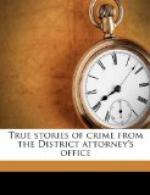Upon the trial of Mrs. Parker the hand-writing experts testified that the Bierstadt and Kauser signatures were so perfect that it would be difficult to state that they were not originals. The Parker woman was what is sometimes known as a “free hand” forger; she never traced anything, and as her forgeries were written by a muscular imitation of the pen movement of the writer of the genuine signature they were almost impossible of detection. When Albert T. Patrick forged the signature of old Mr. Rice to the spurious will of 1900 and to the checks for $25,000, $65,000 and $135,000 upon Swenson’s bank and the Fifth Avenue Trust Co., the forgeries were easily detected from the fact that as Patrick had traced them they were all almost exactly alike and practically could be superimposed one upon another, line for line, dot for dot.[1]
[Footnote 1: See Infra, p. 304.]
[Illustration: Fig. 5.—Practice signatures of the name of Alice Kauser.]
Mabel Parker’s early history is shrouded in a certain amount of obscurity, but there is reason to believe that she was the offspring of respectable laboring people who turned her over, while she was still an infant, to a Mr. and Mrs. Prentice, instructors in physical culture in the public schools, first of St. Louis and later of St. Paul, Minnesota. As a child, and afterwards as a young girl, she exhibited great precocity and a considerable amount of real ability in drawing and in English composition, but her very cleverness and versatility were the means of her becoming much more sophisticated than most young women of her age, with the result that while still in her teens she gave her adopted parents ground for considerable uneasiness. Accordingly they decided to place her for the next few years in a convent near New York. By this time she had attained a high degree of proficiency in writing short stories and miscellaneous articles, which she illustrated herself, for the papers and inferior magazines. Convent life proved very dull for this young lady, and accordingly one dark evening, she made her exit from the cloister by means of a conveniently located window.
Waiting for her in the grounds below was James Parker, twenty-seven years old, already of a large criminal experience, although never yet convicted of crime. The two made their way to New York, were married, and the girl entered upon her career. Her husband, whose real name was James D. Singley, was a professional Tenderloin crook, ready to turn his hand to any sort of cheap crime to satisfy his appetites and support life; the money easily secured was easily spent, and Singley, at the time of his marriage, was addicted to most of the vices common to the habitues of the under world. His worst enemy was the morphine habit and from her husband Mrs. Singley speedily learned the use of the drug. At this time Mabel Prentice-Parker-Singley was about five feet two inches in height, weighing




